



Forest science and Landscape managemet
Performance of Eucalyptus tereticornis provenances in subtropical climate
Comportamiento productivo de orígenes de Eucalyptus tereticornis en clima subtropical
Comportamento produtivo de origens de Eucalyptus tereticornis em clima subtropical
Agrociencia Uruguay
Universidad de la República, Uruguay
ISSN-e: 2730-5066
Periodicity: Bianual
vol. 25, no. 1, e322, 2021
Received: 13 February 2020
Accepted: 18 November 2020
Published: 12 April 2021
Corresponding author: gbalmelli@inia.org.uy

Abstract: Eucalyptus tereticornis has a wide natural geographic distribution from Papua New Guinea to South Australia (6º-38º S), therefore, it is expected the existence of important differences among provenances. Although differences in performance among provenances have been reported in several countries, the existing information is insufficient to allow the choice of the most appropriate provenance as a source of seeds for commercial plantations for humid subtropical climates. In order to evaluate the performance of 20 provenances of E. tereticornis in Uruguay and to generate information that contributes to the identification of the best provenances for humid subtropical climates, survival, individual tree volume, stem straightness and forking were assessed at 9-years-old in 4 sites in the center, north and northeast of Uruguay. Significant differences among provenances for all traits and significant provenance by site interaction for survival, individual tree volume and forking were found. No provenance was best in all sites. The Buckenbowra provenance had simultaneously high volume and survival. The absence of a clear regionalization, coupled with a significant provenance-by site interaction, suggests that local evaluation of different provenances is essential to identify appropriate seed sources, both for tree breeding and for use in commercial plantations.
Keywords: genotype by environment interaction, forking, stem straightness, survival, volume.
Resumen: Eucalyptus tereticornis es una especie que tiene una amplia distribución geográfica natural, desde Papúa Nueva Guinea hasta Australia del Sur (6º-38º S), por lo tanto, es esperable la existencia de importantes diferencias entre procedencias. Aunque se han reportado diferencias en el rendimiento entre procedencias en varios países, la información existente es insuficiente para permitir la elección de la procedencia más apropiada como fuente de semillas para plantaciones comerciales en climas subtropicales húmedos. Para evaluar el desempeño de 20 procedencias de E. tereticornis en Uruguay y generar información que contribuya a la identificación de las mejores procedencias en climas subtropicales húmedos se evaluó supervivencia, volumen individual, rectitud del fuste y presencia de bifurcaciones a los 9 años de edad, en 4 sitios en el centro, norte y noreste de Uruguay. Como resultado, se encontraron diferencias significativas entre procedencias para todas las características y significativa interacción sitio por procedencia para supervivencia, volumen individual y presencia de bifurcaciones. Ninguna procedencia fue mejor en todos los sitios. La procedencia de Buckenbowra tuvo simultáneamente un alto volumen y supervivencia. La ausencia de una clara regionalización, junto con una interacción significativa de procedencia por sitio, sugiere que la evaluación local de las diferentes procedencias es esencial para identificar las fuentes de semillas apropiadas para el cultivo de esta especie y su uso en plantaciones comerciales.
Palabras clave: interacción genotipo por ambiente, presencia de bifurcaciones, rectitud de fuste, supervivencia, volumen.
Resumo: Eucalyptus tereticornis é uma espécie que apresenta ampla distribuição natural, desde Papua Nova Guiné até o Sul da Austrália (6º-38º S), portanto, espera-se a existência de diferenças importantes entre procedências. Embora diferenças de rendimento entre procedências tenham sido relatadas em vários países, as informações existentes são insuficientes para permitir a escolha da procedência mais apropriada como fonte de sementes para plantações comerciais em climas subtropicais úmidos. Para avaliar o desempenho de 20 procedências de E. tereticornis no Uruguay e gerar informações que contribuam para a identificação das melhores procedências em climas subtropicais úmidos, avaliou-se a sobrevivência, o volume individual, a retidão do fuste e a presença de bifurcações aos 9 anos de idade, em quatro locais em centro, norte e nordeste do Uruguay. Como resultado, foram encontradas diferenças significativas entre procedências para todas as características e interação sitio-procedência significativa para sobrevivência, volume individual e presença de bifurcações. Nenhuma procedência foi melhor em todos os locais. A procedencia de Buckenbowra foi simultaneamente de alto volume e sobrevivencia. A ausência de uma regionalização clara, juntamente com uma interação significativa procedência por sitio, sugere que a avaliação local das diferentes procedências é essencial para identificar fontes de sementes apropriadas para o cultivo desta espécie e para uso em plantações comerciais.
Palavras-chave: interação genótipo-ambiente, presença de bifurcações, retidão do fuste, sobrevivência, volumen.
1. Introduction
Eucalyptus tereticornis Sm. has the largest natural distribution range among eucalypts species, from Papua New Guinea to South Australia (6-38ºS), from sea level to 1000 m in Australia and 1800 m in Papua New Guinea(1). It is found in coastal and continental areas, with variable climate, from tropical (North) to cold temperate (South), with an average maximum temperature of 24-36 ºC and minimums of 1-19 ºC, with up to 30 frosts per year. The annual rainfall ranges from 500 to 3000 mm, with a variable regime, from monsoonal in Papua New Guinea to summer rains in Queensland, an evenly distributed rains in New South Wales or winter rains in Victoria(2).
At the end of the 19th century, E. tereticornis was introduced in different countries(2). Its cultivation has spread widely, mainly to areas with annual rainfall between 800 and 1500 mm. However, due to its great plasticity, it has been planted in areas of low rainfall (400 mm in India, 550 mm in Israel, and 580 mm in Zimbabwe) and in areas of high precipitation (2180 mm in Colombia and 3500 mm in Papua New Guinea)(3). In India, one of the world´s largest growers of Eucalyptus, with an area of 3.94 million hectares of plantations, E. tereticornis and an interspecific hybrid of this species are the predominant species in the southern plains(4)(5). The species has been widely used in other countries, as in Zaire, Pakistan (in agroforestry systems) and Colombia (in the Atlantic coast, mainly in reforestation programs with small landowners)(2)(3)(4)(6). In Uruguay, the species was introduced in 1853 and due to its adaptation to a wide variety of soils, it was one of the most cultivated species until the middle of 20th century, mainly for shade and shelter for livestock, but also for productive purposes (poles, wood for carpentry and floors) and energy (firewood and charcoal)(7).
Given the great variability of environments in which this species occurs naturally, the existence of important differences among provenances is quite expected. Although differences in performance among provenances have been reported in several countries(8)(9)(10)(11), the existing information is insufficient to allow the choice of the most appropriate provenance as a source of seeds for commercial plantations. For this reason, the aim of the present study was to evaluate the performance of different provenances of E. tereticornis in the subtropical climate of Uruguay to generate information that contributes to the identification of the best provenances for humid subtropical climates.
2. Materials and methods
2.1 Genetic material and field trials
The data analyzed in this work comes from the breeding population of E. tereticornis of inia (National Institute of Agricultural Research), Uruguay, which comprises 100 open-pollinated families, of 20 provenances that cover a large part of the natural distribution of this species, introduced from csiro (Commonwealth Scientific and Industrial Research Organization), Australia (Table 1). The evaluation of productive performance was carried out in 4 provenance trials, established in representative sites of the country, in 2008 and 2009. The sites have a similar climate and vary in soil characteristics (Table 2). The trials were established using a randomized complete block design, with single-tree plots, and 19 to 21 replications per site. Soil preparation consisted in tillage made in bands, and trees were planted at a spacing of 4×2.5 m (1000 trees/ha) in all sites.
| Provenance | State | Number of mother trees | Latitude ('S) | Longitude ('W) | Altitude (m) |
| Mill Stream Archer Creek | QLD | 4 | 17° 39 | 145° 21 | 670 |
| Mount Garnet | QLD | 6 | 17° 40 | 145° 00 | 640 |
| Cardwell | QLD | 5 | 18° 10 | 145° 58 | 84 |
| SW of Mount Garnet | QLD | 1 | 18° 24 | 144° 45 | 890 |
| Burdekin River | QLD | 8 | 19° 48 | 146° 04 | 291 |
| Crediton SF | QLD | 9 | 21° 17 | 148° 31 | 730 |
| Marlborough | QLD | 5 | 22° 52 | 149° 48 | 100 |
| Raglan Creek | QLD | 5 | 23° 43 | 150° 52 | 20 |
| Calliope River | QLD | 5 | 23° 57 | 151° 09 | 30 |
| Kalpower | QLD | 5 | 24° 40 | 151° 19 | 350 |
| Bunya SF | QLD | 1 | 26° 48 | 151° 35 | 440 |
| W of Warwick | QLD | 3 | 28° 11 | 151° 39 | 485 |
| Warwick | QLD | 5 | 28° 15 | 152° 05 | 450 |
| Maryland | NSW | 8 | 28° 29 | 152° 05 | 750 |
| Selection Flat SF559 | NSW | 10 | 29° 10 | 152° 58 | 40 |
| N of Woolgoolga | NSW | 1 | 29° 55 | 153° 12 | 30 |
| Buckenbowra SF | NSW | 5 | 35° 40 | 150° 07 | 110 |
| Yurammie SF | NSW | 4 | 36° 49 | 149° 45 | 170 |
| S of Loch Sport | VIC | 8 | 38° 03 | 147° 01 | 2 |
| Loch Sport | VIC | 2 | 38° 03 | 147° 36 | 5 |
2.2 Traits evaluated
Survival, diameter at 1.3 m (dbh), total tree height (H), stem form and incidence of forking were assessed at 9-year-old. All surviving trees were measured for dbh, with diametric tape, and h, with hypsometer (Vertex iv hs 102). The stem straightness and forking were both assessed visually, with grading scales of 1 (straight stem) to 3 (twisted stem), and 0 (without forks) to 2 (more than one fork), respectively. Individual tree volume with bark (vol) was calculated for each tree, using the general equation: vol= 3.1415/4(dbh2)*h*f, where f is the form factor, with a value of 0.4. Since there is no adjusted volume equation for this species, an f of 0.4 was assumed to correct taper.
| Site 1 | Site 2 | Site 3 | Site 4 | |
| Location (Department) | Route 5, km 438 (Rivera) | El Carmen (Durazno) | Carlos Reyles (Durazno) | Vergara (Treinta y Tres) |
| Latitude | 31° 25.419' S | 33° 19.616 'S | 33° 5.291' S | 32° 45.747' S |
| Longitude | 55° 39.703' W | 56° 6.313' W | 57° 4.621' W | 54° 0.869' W |
| Altitude (m) | 185 | 128 | 58 | 98 |
| Mean minimum annual temperature | 13.5 ºC | 11.3 ºC | 11.3 ºC | 12.1 ºC |
| Mean annual temperature | 18.6 ºC | 17.2 ºC | 17.2 ºC | 17.7 ºC |
| Mean maximum annual temperature | 23.7 ºC | 23.1 ºC | 23.1 ºC | 23.4 ºC |
| Mean annual rainfall | 1558 mm | 1159 mm | 1159 mm | 1409 mm |
| Soil characteristics | ||||
| Depth | Deep | Deep | Shallow to moderately Deep | Shallow |
| Drainage | Good | Good | Moderately Good | Poor |
| Fertility | Low | Low to medium | Medium | Low |
| Texture | Sandy loam | Sandy loam | Clay loam | Loam |
2.3 Data analysis
Analysis of variance of each trait was carried out jointly for all sites, using the following mixed model:
yijk = μ + sitei + repj(i) + provk + site.provik + εijk
where yijk is the observed value in the j-th replication of the i-th site, pertaining to k-th provenance; μ is the overall mean value; sitei is the effect of the i-th site; repj(i) is the effect of the j-th replication within the i-th site; provk is the effect of the k-th provenance; site.provik is the interaction effect between the i-th site and the k-th provenance; εijk is the random error. Site and provenance effects were considered as fixed factors and the effect of replications as a random factor. The significance of the fixed effects was determined by analysis of variance (anova). Due to the heterogeneity variances among treatments the contrasts of means were carried out using the Tukey hsd test with 95% confidence. The statistical analyses were carried out using the R3.4.1 software(12). For the survival analysis, a binomial distribution was considered, assigning 0 for a dead tree and 1 for a living tree.
The study of the adaptability of the provenances in the different sites was analyzed according to Finlay and Wilkinson(13). For each provenance present in at least three sites, a linear regression of individual volume on the mean of all provenances for each site was computed. The provenances mean and the regression lines illustrate different types of responses to the range of environments. The population mean has a regression coefficient of 1, so coefficients approximating to 1 indicate average stability. When this is associated with high mean yield, provenances have good general adaptability; when associated with low mean yield, provenances are poorly adapted to all environments. In contrast, regression coefficients above 1 describe provenances with greater adaptability to high-yield sites, and below 1 to provenances more adapted to low-yield sites.
3. Results
For all traits, a significant effect of site (p < 0.001) and provenance (p < 0.001) was found. The provenance by site interaction was significant for all traits, except for stem straightness (p = 0.1025), so survival, individual tree volume and forking were evaluated in each site separately.
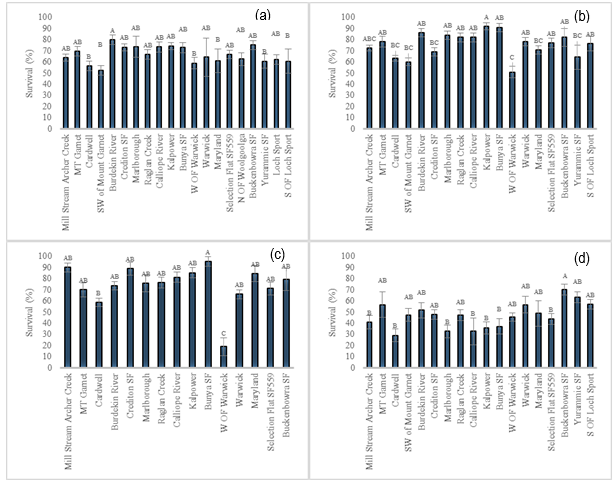
3.1 Survival
Differences among provenances for survival were pronounced (p < 0.001) in all sites. In the Rivera trial, survival ranged between 52 to 79%. The provenance that had the greatest survival was Burdekin River, significantly overcoming the Maryland, s of Loch Sport, Yurammie sf, w of Warwick, Cardwell, and sw of Mount Garnet provenances (Figure 1a). In El Carmen, survival ranged between 51 to 92%, being Kalpower the provenance with higher survival, statistically overcoming Maryland, Crediton sf, Yurammie sf, Cardwell, sw of Mount Garnet, and w of Warwick provenances (Figure 1b). The higher differences between provenances were recorded in the Carlos Reyles trial, with survival values that varied between 19 to 95%. Bunya sf exhibited the greatest survival, although it was only significantly higher than Cardwell and w of Warwick provenances, which had the lowest survival (Figure 1c). Large differences between provenances were also recorded in Vergara, where survival ranged between 28 to 70%. The provenance that had higher survival was Buckenbowra sf, differing only from the Selection Flat sf559, Mill Stream Archer Creek, Bunya sf, Kalpower, Marlborough, Calliope River, and Cardwell provenances (Figure 1d).
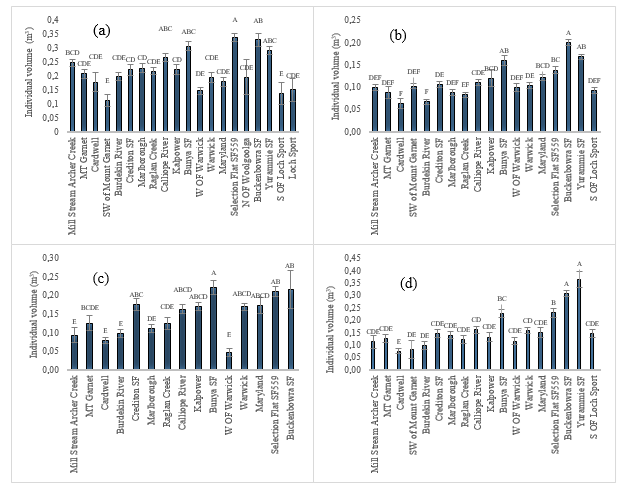
3.2 Individual volume
Significant differences (p < 0.001) among provenances for growth rate were found in all sites. In Rivera, the most productive site, the average vol ranged from 0.34 to 0.11 m3. Provenance Selection Flat sf559 was the fastest growing, overcoming the rest of the provenances, except for Buckenbowra sf, Bunya sf, Yurammie sf, and Calliope River, with which it did not differ significantly (Figure 2a). The mean vol in El Carmen ranged from 0.20 to 0.065 m3. Buckenbowra sf was the provenance with higher growth in this trial, significantly surpassing the other provenances, except for Yurammie sf and Bunya sf, with which there were no significant differences (Figure 2b). In Carlos Reyles, where vol ranged from 0.23 to 0.04 m3, the Bunya sf provenance had the greatest growth, although it only significantly exceeded the provenances of mt Garnet, Raglan Creek, Marlborough, Burdekin River, Mill Stream Archer Creek, Cardwell, and w of Warwick (Figure 2c). Vergara was the site with larger differences in growth rate, with a vol that ranged from 0.36 to 0.076 m3. Yurammie sf and Buckenbowra sf were the provenances with higher growth (Figure 2d).
The regression analysis shows that the provenances of Buckenbowra sf, Raglan Creek, Burdekin River, mt Garnet, Cardwell, Yurammie sf, Crediton sf and Kalpower have a regression coefficient close to 1, thus indicating a stable behavior across sites (Figure 3 and Table 3). In contrast, some provenances have regression coefficients greater than 1 (Selection Flat sf559, Mill Stream Archer Creek and Calliope River) or less than 1 (sw of Mount Garnet, s of Loch Sport, Maryland and w of Warwick), being therefore responsible for the provenance by site interaction. Within the group of stable provenances, Buckenbowra sf and Yurammie sf have a mean volume greater than the whole provenances average, so they have good general adaptability, and Cardwell and Burdekin River have lower volume than the average, showing poor general adaptability (poor performance in all sites).
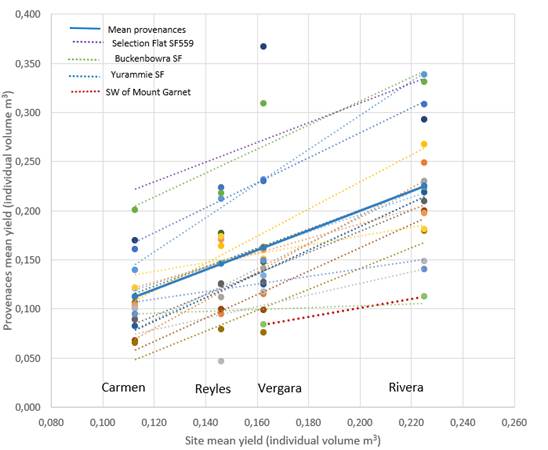
| Provenances | Mean individual volume (m3) | b |
| Selection Flat SF559 | 0.23 | 1.74 |
| Mill Stream Archer Creek | 0.14 | 1.43 |
| Calliope River | 0.18 | 1.38 |
| Marlborough | 0.14 | 1.29 |
| Bunya SF | 0.23 | 1.27 |
| Buckenbowra SF | 0.26 | 1.21 |
| Raglan Creek | 0.14 | 1.2 |
| Burdekin River | 0.12 | 1.19 |
| MT Garnet | 0.14 | 1.07 |
| Cardwell | 0.10 | 1.06 |
| Yurammie SF | 0.28 | 1,00 |
| Crediton SF | 0.16 | 0.96 |
| Kalpower | 0.16 | 0.87 |
| Warwick | 0.16 | 0.73 |
| W of Warwick | 0.10 | 0.59 |
| Maryland | 0.16 | 0.45 |
| S of Loch Sport | 0.13 | 0.38 |
| SW of Mount Garnet | 0.10 | 0.1 |
3.3 Forking
Forking scores showed marked provenance differences (p < 0.001) in all sites. The mean incidence of forking ranged from 0.4 to 1.3 in the Rivera trial. The n of Woolgoolga, w of Warwick, Yurammie sf, and Kalpower provenances showed the lowest number of forks, although they only significantly differed from the s of Loch Sport and Loch Sport provenances, which presented the highest incidence of forking (Figure 4a). El Carmen was the site with the greatest differences among provenances, with an incidence of forking ranging from 0.25 to 1.35. The Raglan Creek, Marlborough, Cardwell and Burdekin River provenances showed the best performance in this trait (low incidence of forking), although they only overcome the mt Garnet, Bunya sf, Maryland, Buckenbowra sf and s of Loch Sport provenances (Figure 4b). In Carlos Reyles, where the mean incidence of forking ranged from 0.16 to 0.87, all provenances showed low incidence of forking, except Crediton sf, Bunya sf and Maryland provenances (Figure 4c). In the Vergara trial, the mean incidence of forking ranged from 0.14 to 0.97. The Bunya sf provenance had the lowest number of forks, although it only significantly differed from the Maryland provenance (Figure 4d).
3.4 Stem straightness
As mentioned above, there was no provenance by site interaction for stem straightness. This trait showed little differences among provenances, except for Loch Sport and Yurammie sf, which clearly had very bad form (twisted stems) (Figure 5).
4. Discussion
It should be noted that the provenances evaluated in this study are represented by few mother trees, and that some, such as sw of Mount Garnet or n of Woolgoolga, come from a single mother tree, which could be a limitation when characterizing their productive performance. Even so, both in the adaptive and growth traits (survival and vol, respectively), and in the traits related to stem form (straightness and incidence of forking) there were statistically significant differences among provenances. In addition, all traits evaluated, except stem straightness, presented significant provenance by site interaction, indicating that the relative performance of provenances varies even with minor differences in the climate and/or soil where trees were cultivated. These results confirm that the great variety of environments in which E. tereticornis developed has generated a significant variation in the adaptability and performance of different provenances.
Given that the annual average rainfall is not a limitation for the development of this species in the 4 sites evaluated (1159-1558 mm) and that the temperature is very similar between the sites, the differences in productive traits across the sites could be explained by the characteristics of the soils. In sites with deep soils, light textures and good drainage, which allow a good root development, the survival and vol were greater than in sites with more superficial soils, heavier textures and worst drainage. In contrast, the incidence of forking was lower at sites with shallower and heavier textured soils. These results demonstrate the importance of considering the soil as a key factor for the performance of this species, mainly when the rainfall is not a limiting factor.
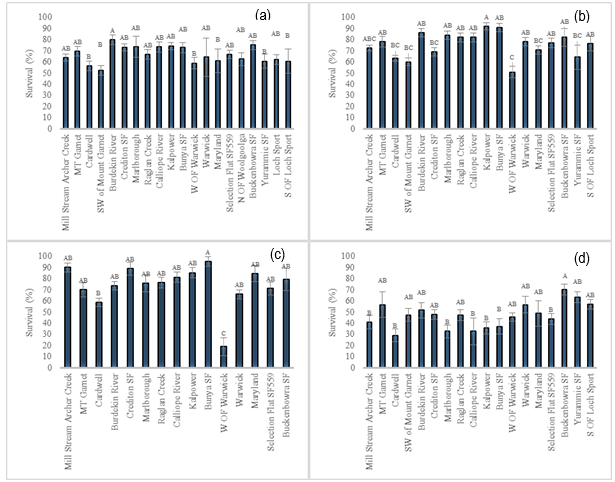
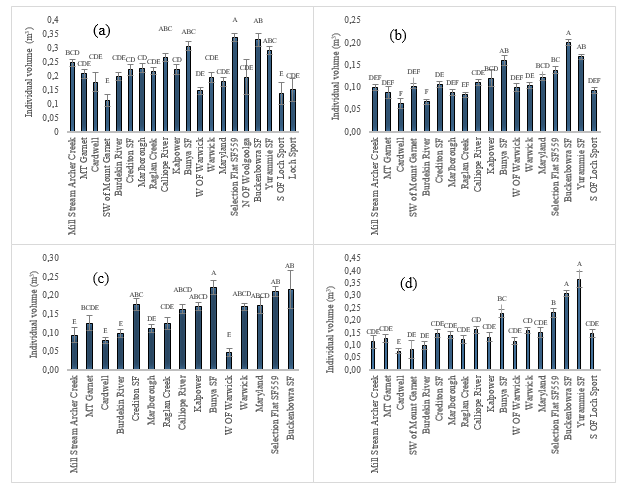
Although no clear regionalization was observed, in general the provenances with highest growth rate were those from latitudes between 25 and 37ºS (South Queensland and New South Wales). This region has also been reported as the most productive in Zimbabwe and Argentina(2)(11)(14). On the other hand, in the present work it was observed that all subtropical provenances, of latitudes below 19ºN (North of Queensland), had poor performance in Uruguay. However, it has been reported that the best provenances for Bangladesh, Brazil, Nigeria, Mozambique and from South to East of India are found in that region(2)(10)(15)(16)(17)(18).
No provenance was the best in all sites to all the traits evaluated. But in terms of individual tree volume, the Buckenbowra sf, Yurammie sf and Bunya sf showed good general adaptability. Buckenbowra sf also presented adequate survival in all sites, so it can be considered as a source of seeds of high performance in Uruguay. The provenances differed markedly in the incidence of forking, highlighting Cardwell, Kalpower, Burdekin River, and w of Warwick, which had low values in all sites. In general, the stem straightness was adequate in all sites evaluated, with small differences among provenances, except for Loch Sport and Yurammie sf, which presented very poor form in Uruguay.
5. Conclusions
The results of this study showed the importance of correctly choosing the source of seeds for commercial plantations of E. tereticornis. In the different trials analyzed, the best provenance had a tree growth (individual volume) 3 to 5 times larger than the worst provenance. However, the absence of a clear regionalization and the existence of a significant provenance by site interaction demonstrate the importance of carrying out the local evaluation of different provenances to be able to choose the best source of seeds. These results also suggest that it is necessary to evaluate more provenances of E. tereticornis, mainly from those areas identified as of better aptitude, like South Queensland and New South Wales, to identify sources of seeds that simultaneously present high productivity and good stem form for the cultivation of this species in humid subtropical climates such as in Uruguay.
Acknowledgments
We would like to thank Pablo Núñez, Federico Rodríguez, Wilfredo González and Santiago García for their assistance on the measurement of the trails. The study was funded by a scholarship awarded by inia (National Institute of Agricultural Research) to the first author.
References
1. Brussa CA. Eucalyptus tereticornis Smith. In: Eucalyptus: especies de cultivo más frecuente en Uruguay y regiones de clima templado. Montevideo: Hemisferio Sur; 1994. p. 176-7.
2. Eldridge K, Davidson J, Harwood C, van Wyk G. Eucalyptus tereticornis. In: Eucalypt domestication and breeding. New York: Oxford University Press; 1994. p. 139-43.
3. Alvarado R, Alvarado A, Mendoza O. Eucalyptus tereticornis Smith. In: Forest Service. Washington (DC): USDA; 2003. p. 470-2.
4. Varghese M, Harwood C, Hegde R, Ravi N. Evaluation of Provenances of Eucalyptus camaldulensis and Clones of E. camaldulensis and E. tereticornis at Contrasting Sites in Southern India. Silvae Genet. 2008;57(3):170-9.
5. Chezhian P, Yasodha R, Modhumita G. Genetic diversity analysis in a seed orchard of Eucalyptus tereticornis. New Forest. 2010;40(1):85-99.
6. López A, Barrios A, Trincado G. Modelos de perfiles fustales con una estructura de error autorregresiva para plantaciones de Eucalyptus tereticornis en Colombia. Madera Bosques. 2015;21(2):73-88.
7. Balmelli G, Resquín F. Eucaliptos Colorados: una alternativa para la diversificación productiva. Rev INIA. 2006;(7):35-7.
8. Ferreira J, Krogh H, Menck A, Oda S. Teste de procedência de Eucalyptus para a região subúmida do Estado do Maranhão. Bol Pesq Flor. 1987;15:41-8.
9. Balmelli G, Resquín F. Alternativas forestales para sombra y abrigo en basalto. In: Seminario de Actualización en Tecnologías para Basalto. Montevideo: INIA; 1998. p. 357-67. (Serie Técnica; 102).
10. Ginwal H, Kumar P, Sharma V, Mandal A, Harwood C. Genetic variability and early growth performance of Eucalyptus tereticornis Sm. in provenance cum progeny trials in India. Silvae Genet. 2004;53(4-5):148-53.
11. Marcó M, Harrand L. Valor Potencial de los Eucaliptos Colorados en Combinaciones Híbridas. In: I Jornada Sobre Potencialidad Foresto-Industrial del Eucalipto en Santiago del Estero; 2005 Jun 16-17; Santiago del Estero, Argentina [Internet]. 2005 [cited 2020 Dec 17]. 10p. Available from: https://bit.ly/38eYHGy.
12. R Core Team. R: a language and environment for statistical computing [Internet]. Vienna: R Foundation for Statistical Computing; 2015 [cited 2020 Dec 17]. Availablee from: https://bit.ly/31v5U2G.
13. Finlay KW, Wilkinson GN. The analysis of adaptation in a plant-breeding programme. Aust J Agric Res. 1963;14(6):742-54.
14. Donaq N, Schenone R, Sanchez M. Comportamiento de especies de Eucalyptus en un suelo pesado de la región N.E. de Entre Ríos. Concordia: INTA; 1998. 40p. (Carpeta de Información Forestal; B).
15. Otegbeye GO. Provenance variation in Eucalyptus tereticornis in a field trial within the Northern Guinea Savanna zone of Nigeria. Silvae Genet. 1990;39(3-4):103-7.
16. Kumaravelu G, Stanley J, Rai RSV, Balan S. Provenances of Eucalyptus camaldulensis Dehnh and E. tereticornis Sm suitable to South Indian conditions: results of an IUFRO trial. Ann For Sci. 1995;3(2):129-33.
17. Chamshama SA, Mugasha AG, Wate PA. Variation in performance of Eucalyptus tereticornis provenances at Michafutene, Mozambique. Silvae Genet. 1999;48(6):261-6.
18. Ginwal HS. Provenance and family variation in growth performance of Eucalyptus tereticornis (Sm.) in a provenance cum progeny trial in Midnapore, India. For Ecol Manage. 2009;258(11):2529-34.
Author notes
gbalmelli@inia.org.uy
Additional information
Author
contribution statement: FR and GB: conception, design and performance
of the experiment; MG: data collection, data analysis and manuscript
preparation; GB: supervision of the work and critical revision of the
manuscript.
Editor: The
following editor approved this article.
Jaime
González Talice (ORCID: https://orcid.org/0000-0001-9718-2055) Universidad
de la República, Montevideo, Uruguay.
Alternative link
http://agrocienciauruguay.uy/ojs/index.php/agrociencia/article/view/322/741 (pdf)

